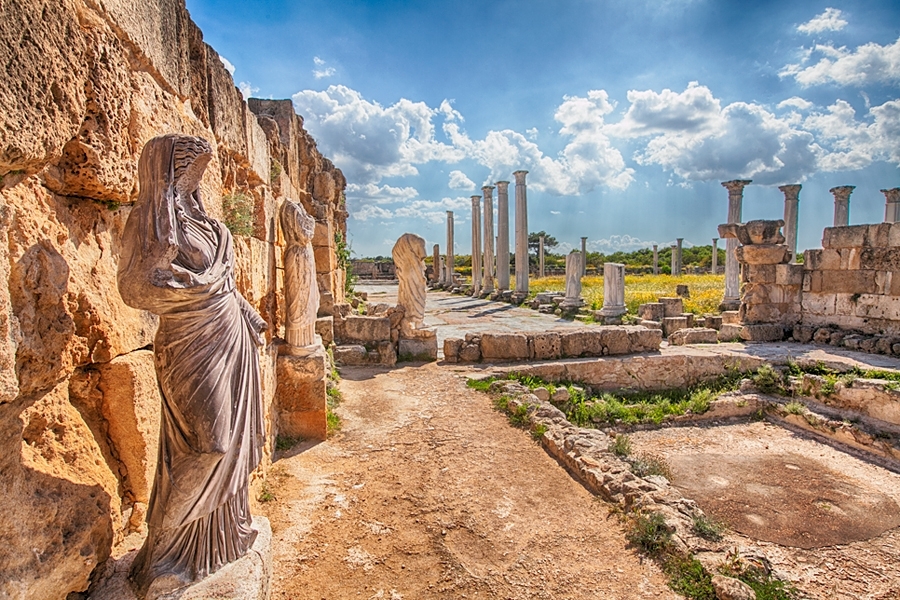North Cyprus Historical Place
North Cyprus Historical Place
North Cyprus, an island which, throughout its history, has been sought after for strategic, political, commercial and religious reasons and which has never lost its attraction…
North Cyprus, with its Neolithic settlement sites, where civilisation was born, its ancient city kingdoms reflecting the glory of the Roman period, a place of refuge for Crusaders, the prized possession of the French Lusignan lords, the most important eastern harbour of the Venetian traders, with the strongest Ottoman castle of the Eastern Mediterranean...
North Cyprus, location of the fortified port which inspired the British playwright William Shakespeare when he wrote his tragedy “Othello”.
North Cyprus, site of the Castle of St Hilarion, model for the castle in Walt Disney’s “Sleeping Beauty”.
North Cyprus, a mysterious emissary of history, with the finest Gothic architecture of the Eastern Mediterranean.
North Cyprus, where Leonardo Da Vinci contributed to the plans for the defence of Gazimağusa, and included the “River Motif” from Lefkara lacework in the design of the tablecloth in his peerless work “The Last Supper”.
North Cyprus, where Lawrence Durrell wrote “Bitter Lemons”, an intercontinental crossroads of faith, the island which the Knights Templar of “Da Vinci Code” fame purchased from Richard the Lionheart for 100,000 Byzantine gold pieces and managed to rule for the space of one year.
North Cyprus, island of immortal mythic love, birthplace of Aphrodite, goddess of Beauty and Love, where the artist King Pygmalion created a statue of a perfect woman and fell in love with her …
North Cyprus, a bright and peaceful setting for a 10,000 year history and cultural heritage, where the sun will warm you for more than 300 days a year, an island ready to welcome you with its stunning natural beauty and untouched beaches….
The island’s tourism accommodation, which offers a wide range of choices, will exceed the expectations of every holidaymaker. You can choose from luxury hotels, family hotels, boutique or ecotourism hotels which have been set up in recent years. These offer the opportunity to bathe in the clear waters of the Mediterranean, fine buffet dining, conference and seminar halls, swimming pools, waterparks, environmentally integrated green spaces, recreation and entertainment activities, gaming and facilities designed for your comfort with everything you need for a comfortable holiday.
From Yeşilırmak village in the west to the Monastery of the Apostolos Andreas in the east, every moment you spend in North Cyprus, a hidden paradise of the world, will add up to a comfortable and unforgettable holiday. North Cyprus richly deserves its reputation as the pearl of the Mediterranean.
Every corner of North Cyprus, with its five districts and population of 300,000, is worth visiting. We are inviting you to a historical, cultural, natural, authentic and romantic holiday in any part of North Cyprus at any time of the year (four seasons and 12 months), from Girne to Lefkoşa, from Güzelyurt to Lefke and from İskele to Karpaz and Gazimağusa.
Every season has something to show in North Cyprus, a green island, with its olive trees, carob trees, cypresses and rolling maquis. The stunning beauty of the plant life of North Cyprus, which has rather productive soils, arrays itself in a different colour in each of the four seasons. It produces citrus fruits such as sweet and bitter oranges, mandarin, oranges , grapefruit and also produces a wealth of vegetables, including its famous potatoes. The shores are lined with eucalyptus and acacia and the mountains with aromatic pines.
The climate of North Cyprus is a healthy one, typically Mediterranean. The summers are long and hot, while the winters are short with little rainfall. Cold winds, frost and snow are virtually unknown in North Cyprus. Precipitation normally takes the form of rain, but occasionally snow falls on the Girne mountain range, vanishing as quickly as it came. The coldest month is January which averages 10°C, while the hottest is July with an average temperature of 40°C. The annual mean temperature is 15°C.
The island of Cyprus in the eastern Mediterranean is 64 km from the coast of Turkey, 96 km from Syria, and 400 km from Egypt. It is the third largest island in the Mediterranean after Sicily and Sardinia. Because of its location, strategically poised at the crossroads of commercial and religious traffic between three continents, Cyprus has hosted a number of civilisations over the centuries. In North Cyprus, which has an area of 3355 km2, you can find the traces of a historic and cultural heritage going back 10,000 years. The first signs of human occupation on the island date from 8,000 BC. You can see the mark left by civilisations over the centuries from the Neolithic period up to the present day, including the Phoenicians, the Assyrians, the Egyptians, the Ptolemaic dynasty, the Persians, the Hellenes, the Romans, the Byzantines, the Lusignans, the Venetians, the Ottoman Empire and the British.
In the course of its history, the island of Cyprus has been known as Alashia, Kittim, Yadnana and Hettim, but its current name derives from copper (also known as cuprum or cyprium) of which the island boasts rich deposits.
Featured


Nevruz Holiday Deals to Antalya: Celebrate Spring in the Turkish Riviera
Details
Holiday Deals to Antalya: Experience the Turkish Riviera with Caria Holidays
Details
Fly to Turkey: Your Ultimate Travel Experience with Caria Holidays
Details
Flight Tickets to Turkey: Find the Best Deals with Caria Holidays
Details
Turkey Ticket Price: Fly with Caria Holidays for the Best Deals
Details
Travel Agency in London: Caria Holidays
Details

